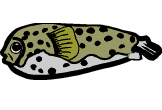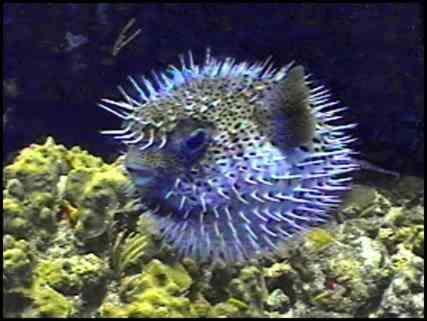
|
|
|
|
|
|
 The
inflation consists of a swelling of the body by taking in air and water.
While doing this the fish will float upside down until it can release the
air. By swelling the puffer becomes too large to consume. Some Puffers
also have small spines (Photo by ScubaMom).
The
inflation consists of a swelling of the body by taking in air and water.
While doing this the fish will float upside down until it can release the
air. By swelling the puffer becomes too large to consume. Some Puffers
also have small spines (Photo by ScubaMom).
Puffers have strong jaws and teeth fused into a parrot-like beak used to crunch open the shells of the crustaceans, molluscs and echinoderms that they feed on.
Another defense which makes the Puffer not an ideal choice is that the flesh of the puffer is suffused with Tetrodotoxin. Tetrodotoxin is a powerful neurotoxin that can cause death in nearly 60% of the humans that ingest it. A human only has to ingest a few milligrams for a fatal reaction to the toxin to occur. Once consumed the toxin blocks the sodium channels in the nervous tissues, ultimately paralyzing the muscle tissue. Curiously, the toxin seems not to be synthesized by the fish itself, but by bacteria associated with the fish! The fish has a mutation in its own sodium channels which makes it resistant to the effect of the toxin.

|
|
Although the Puffer is commonly known to be a deadly food, thousands consider it to be a delicacy. The common parts of the fish that are eaten are the liver, gonads and skin. Specially trained chefs may prepared the food so that it can be safely consumed. It is illegal for anyone else to prepare the fish. Most people who are poisoned have illegally smuggled the fish into the United States. The fish can only be sent to certified fugu chefs. The risk of eating the fish is almost as high as the price of actually purchasing it. In Japan, it costs the equivalent of up to $150 for a single fish. Americans may pay up to $400 to find a single legal meal.